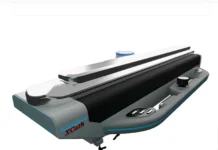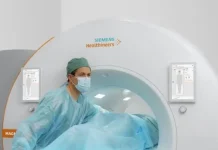Medtronic announced that a study of its Hugo surgical robot met primary safety and effectiveness endpoints.
Results came from the company’s Enable Hernia Repair clinical study evaluating Hugo in inguinal and ventral hernia repair procedures. It marks the first-ever FDA investigational device exemption (IDE) clinical study completed for robotic-assisted hernia surgery in the U.S. Medtronic said.
Hugo is an investigational modular, multi-quadrant platform designed for various surgical procedures. It features wristed instruments, 3D visualization and surgical video capture options in Touch Surgery Enterprise. Medtronic first unveiled Hugo in September 2019 as a potential competitor to long-time industry leader Intuitive Surgical.
Related: Peytant reports positive tracheobronchial covered stent results
Medtronic submitted its soft tissue robotics platform to the FDA for urologic indications in the first quarter of calendar 2025. It expects the submission to propel it toward its planned entrance into the U.S. surgical robotics market. This falls in line with the company’s expectation shared last fall for an early 2025 submission.
As the company looks to go beyond urologic procedures to hernia repair, Enable Hernia Repair met its primary safety and effectiveness endpoints, supporting the use of Hugo in these procedures. Dr. Jacob Greenberg, national principal investigator and gastrointestinal surgeon at Duke University Hospital, said Hugo “far surpassed” the study’s primary endpoints.
“The Enable Hernia Repair clinical study didn’t just meet primary endpoints, it far surpassed them,” said Greenberg. “I am proud to have had the opportunity to advance clinical research in robotic-assisted surgery for the benefit of patients in the United States and around the world.”
More on the Enable Hernia Repair study supporting Hugo
The prospective, multi-center, single-arm pivotal study included 193 patients undergoing either inguinal or ventral robotic hernia repair.
It met the primary effectiveness endpoint with a surgical success rate of 100%, surpassing the pre-specified performance goal of 85%.
Both cohorts, analyzed independently, met their primary safety endpoints. Among 92 patients available for analysis, the surgical site event (SSE) rate came in at 0% for the inguinal population. That registered significantly lower than the pre-determined performance goal of 30%. Among 94 patients in the ventral group, the SSE rate came in at 2.1%, again coming in well below the goal of 30%. Medtronic said investigators recorded two SSE events and resolved them without complication.
Enable Hernia Repair saw a mean length of hospital stay totaling 4.7 hours for inguinal patients and 6.7 hours for ventral.
“We’re grateful for the opportunity to partner with clinical teams to treat this common and often painful condition for millions of patients around the world,” said Rajit Kamal, vice president and general manager of Robotic Surgical Technologies within the Surgical business of Medtronic. “Adding a digitally-powered robotic-assisted surgery system to our laparoscopic and open surgery solutions for hernia repair gives surgeons more choice and patients greater access to the care they need — and we believe that’s a win for everyone.”
Hugo remains under FDA review for a urology indication and the company expects approval later in its fiscal year. It then expects hernia and gynecology to follow. While unavailable in the U.S. at present, Hugo has CE mark approval and availability in certain geographies.






